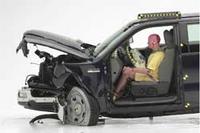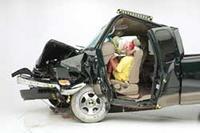Ford F-150, Freestar Get Top Safety Marks in High Speed Crash
Test

2004 F 150 After Crash Test
|

2001 F 150 After Crash Test
|
DETROIT, Dec 19, 2003; Reuters reported that Ford Motor
Co.'s new F-150 pickup and Freestar minivan received top
ratings in an insurance industry group's crash tests designed
to simulate high-speed collisions.
The Insurance Institute for Highway Safety said on Friday
both vehicles earned "good" ratings in 40-mile-per-hour frontal
crashes into barriers designed to strike only the driver's side
of the vehicle.
The institute says a good rating means that, in a real crash
of similar severity, a belted driver would be likely to walk
away with minor injuries.
The IIHS also gave both vehicles "Best Pick" designations
among their competitors. The previous version of the F-150 had
been rated "poor" by the institute, while the Ford Windstar
minivan had been rated "acceptable."
In an unusual step, Ford requested the tests by the
institute and reimbursed the group for the cost of the
vehicles. The IIHS tests have become a closely watched measure
of crashworthiness, and several automakers tout good results in
advertising, especially for minivans and other family
vehicles.
IIHS Press Release
ARLINGTON,VA December 19, 2003: The redesigned Ford F-150 pickup truck and Ford Freestar minivan
each earned the highest overall rating in a recent series of 40 mph
frontal crash tests conducted by the Insurance Institute for Highway
Safety. Both vehicles, which are 2004 models, improved compared with
their predecessors. The previous F-150 model
was rated poor, while the redesigned 2004 model F-150 earned a good
rating and the added designation of "best pick." Ford's
previous minivan, the Windstar, was rated acceptable, while the new
Freestar earned a rating of good and also is a "best pick."
Vehicle
ratings reflect performance in 40 mph frontal offset crash tests
into a
deformable barrier. Based on the results, the Institute evaluates
the crashworthiness of passenger vehicles, assigning each vehicle
a rating from good overall to poor. If a vehicle earns a good rating,
it means that in a real-world crash of similar severity a belted
driver would be likely to walk away with minor injuries. A "best
pick" designation means the vehicle performed well across
the board in the
40 mph crash test.
"The
good crash test results of the F-150 pickup and the Freestar minivan
mean that Ford has the top-rated full-size pickup truck
and one of the two top-rated minivans in the Institute's frontal
crashworthiness evaluations," says Institute president Brian
O'Neill.
Intrusion
measures are much lower for new F-150: "The F-150 went from the worst
performing large pickup we've tested to
the best performing large pickup," O'Neill says. "When
we tested the old F-150, there was massive collapse of the
occupant compartment, and as a result high injury forces were recorded
on the driver dummy. In contrast, the compartment of the new
F-150
held up extremely well in the offset test, the dummy's movement
was well controlled, and all injury measures were low."
Measured intrusion (centimeters) in 40 mph frontal offset tests
Minivan
also improves: The Freestar minivan's driver space
was maintained well in the offset test, and the dummy moved
back into the seat without its head coming close
to any stiff
structure
that could cause injury. In contrast, the old Windstar
had too much upward movement of the steering wheel, which
could
compromise
the
performance of the restraint system. Intrusion
into the Windstar's footwell area contributed to moderately
high forces on the dummy's left leg.
"The
new Freestar and the Toyota Sienna are the only two minivans that
are rated good and also are 'best picks' in
the
Institute's frontal offset crash test," O'Neill
says.
Ford
requests tests: It's unusual for the Institute to release
crash test results for
vehicles from just one manufacturer. Ford requested
the tests of the F-150 and Freestar early in
the model year, and it's
long-standing Institute policy to grant such
requests if the manufacturer reimburses
the Institute for the cost
of the vehicles. The National Highway Traffic
Safety Administration, the federal agency that
also conducts crashworthiness evaluations,
has a similar policy.
Structural
design is key to good performance: The Institute's frontal
offset test into a
deformable barrier is especially
demanding of vehicle structure. The driver
side
hits the barrier, so a relatively small area
of the vehicle's front-end structure must
manage the crash energy. This means
intrusion into the occupant compartment
is more likely to occur than in a full-width
test.
"Good
structural design is the key to good performance in the offset test,"
O'Neill
says. "If a vehicle's
front-end
structure absorbs and manages the crash
energy so the occupant compartment remains largely
intact, with little or no intrusion
into the driver's
space, then the dummy's movement can be
controlled, and injury measures are likely to be low.
In contrast, poor structural
design means greater
likelihood of poor control of the dummy
and high injury measures."
Institute
and government tests complement each other: The
Institute's crashworthiness evaluations
are based
on results of frontal
offset crash tests at 40 mph. Each vehicle's
overall evaluation is
based on three aspects of performance
-- measurements of occupant compartment intrusion, injury
measures from a Hybrid III dummy positioned
in the driver seat, and analysis of slow-motion
film to assess how well the restraint
system controlled dummy movement during
the test.
The
federal government has been testing
new passenger vehicles in 35 mph full-front crash tests since 1978.
This New
Car Assessment Program has been
a major
contributor to crashworthiness improvements -- in
particular, improved restraint systems
in new passenger vehicles. The Institute's
offset tests, conducted since 1995,
involve 40 percent of a vehicle's front end hitting a deformable
barrier
at 40 mph. This test complements
the federal test involving the full
width of the front end hitting a rigid barrier. Both tests are
contributing
to improvements
in crashworthiness -- in particular improved
crumple zones and safety cages.
The same
40 mph offset crash test is used to evaluate new cars by the European
Union in
cooperation with motor clubs,
by an
Australian
consortium of state gov-ernments
and motor clubs, and by a government-affiliated
organization in Japan.




